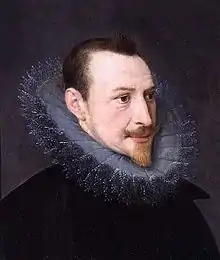Kilcolman Castle
Kilcolman Castle is a tower house located in County Cork, Ireland. It was formerly the residence of the poet Edmund Spenser.[1][2][3]
| Kilcolman Castle | |
|---|---|
| Native name Irish: Caisleán Chill Cholmáin | |
.jpg.webp) Illustration of the castle, 1885 | |
| Type | tower house |
| Location | Kilcolman East, Buttevant, County Cork, Ireland |
| Coordinates | 52.250380°N 8.610485°W |
| Built | c. 1420s |
| Owner | Office of Public Works |
 Location of Kilcolman Castle in Ireland | |
Location
Kilcolman Castle is located 4.4 km (2.7 mi) east-northeast of Buttevant, on the northeast edge of Kilcolman Bog, near the upper branches of the River Awbeg and south of the Ballyhoura Mountains.[4]
History
This was anciently the site of a ringfort named Cathair Gobhann, "the smith's cathair", belonging to the Uí Rossa tribe of Mogh Ruith.[5]
The castle was built in the 1420s by James FitzGerald, 6th Earl of Desmond, who bought the land from William, Lord Barry around 1418.[6]

Confiscated by the Crown after the Second Desmond Rebellion (1579–1583), the castle passed to Philip Sidney. He granted it, together with 3,028 acres (12.25 km2) of land, to Edmund Spenser around 1586–1587.[7] He refurbished the castle and lived there for ten years, during which time, he wrote his epic poem The Faerie Queene (published 1590–96), inspired by the Tudor conquest of Ireland and influenced by the wild Munster scenery. He also wrote A View of the Present State of Irelande, Epithalamion, the Amoretti sonnet sequence and Colin Clouts Come Home Againe.[8]
In 1598, during the Nine Years' War, Kilcolman Castle was destroyed by the forces of Hugh O'Neill, Earl of Tyrone. Spenser escaped; his son Sylvanus rebuilt Kilcolman but it was again destroyed in 1622 and, afterwards, abandoned.[9][10]
Description
It is a typical late mediaeval tower house with a bawn (a curtain wall).[11] It is four storeys tall; on the interior were a basement, parlour, armoury, privy, chapel, study and private rooms.[12]
.jpg.webp)
References
- Hamilton, Albert Charles (13 July 1997). The Spenser Encyclopedia. University of Toronto Press. ISBN 9780802079237 – via Google Books.
- Croker, Thomas Crofton; Wexford.), Jane Adams (of co (13 July 1824). "Researches in the south of Ireland, with an appendix [by J. Adams] containing a private narrative of the rebellion of 1798" – via Google Books.
- Burlinson, Christopher (13 July 2006). Allegory, Space and the Material World in the Writings of Edmund Spenser. DS Brewer. ISBN 9781843840787 – via Google Books.
- "Kilcolman Castle". Archived from the original on 13 July 2019.
- "Archived copy" (PDF). Archived from the original (PDF) on 14 December 2017. Retrieved 13 July 2019.
{{cite web}}: CS1 maint: archived copy as title (link) - "Centering Spenser: A Digital Resource for Kilcolman Castle". core.ecu.edu.
- "Kilcolman Castle - Scenery and Antiquities of Ireland". www.libraryireland.com.
- "Not the people's poet". The Irish Times.
- "Kilcolman Walk: Rare plants and old stories spring up at Kilcolman". www.irishexaminer.com. 3 November 2014.
- "Kilcolman Castle - Irish Pictures (1888)". www.libraryireland.com.
- Klingelhofer, Eric (19 July 2013). Castles and Colonists: An Archaeology of Elizabethan Ireland. Manchester University Press. ISBN 9781847797735 – via Google Books.
- "Centering Spenser: A Digital Resource for Kilcolman Castle". core.ecu.edu.